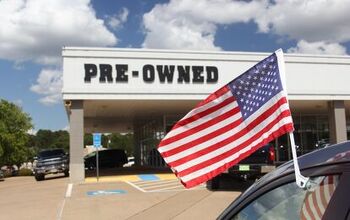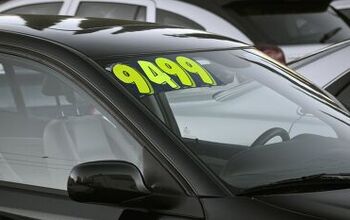Report: Wholesale Used Car Prices Decline Slightly

Wholesale used-vehicle prices reportedly saw a modest dip through the end of last month. However, it wasn’t enough to rationalize running out to the nearest automotive auction or setting up camp near your preferred dealership as you wait for the savings to come rolling in.
Cox Automotive’s Manheim Index, which tracks wholesale used-vehicle pricing for Manheim auctions, only dropped 2.3 percent in October. While that does mean rates were lower than they were in September, we’re still nowhere near the secondhand valuations seen before prices spiked in 2020.
According to Automotive News, Black Book likewise reported that “ higher than typical seasonal wholesale price depreciation resumed” in the first week of November. That means values dropped more than they had anticipated based on annual averages. While that still resulted in a weekly difference of less than one percent, it’s a steeper desperation curve than analysts had anticipated.
It’s not enough to pin anything on. But it at least suggests that demand for vehicles may be cooling off. Deciding what to attribute the change to is also exceptionally tricky. New and used pricing has been exceptionally high for quite some time, vehicle production has been tragically unreliable since 2020, and we have a large portion of the American population that’s being priced out of just about everything. However, Cox and Black Book suggested that the UAW strike's end
probably played a meaningful role.
"The UAW strike appears to be settled, avoiding one action that could have led to higher wholesale prices," Cox Automotive Senior Manager of Economic and Industry Insights Chris Frey said.
From Automotive News:
Had the strike lasted through the end of October or November and caused more significant depletion of new-vehicle inventory, dealers could have become more aggressive in finding used alternatives at wholesale auctions and in other channels, Cox Automotive Chief Economist Jonathan Smoke said last month during a quarterly call about the Manheim index. Periods of more intense buying by dealers can drive wholesale price appreciation.
On that call, Smoke said he is particularly focused on what impact interest rates could have in the fourth quarter and beyond. If they go up, vehicle affordability could worsen and cut into consumer demand, he said.
"It's a very difficult kind of time to forecast exactly what's going to be taking place," Smoke said. "This is really something not dissimilar to the early days of the pandemic where we basically need to monitor what's happening week to week in terms of the supply and the buying activity we see in the market and how that's manifesting in both new and used prices."
It’s a pretty volatile market right now and everyone but the richest families appear to be struggling financially. Meanwhile, new vehicle inventories have increased. But they’re presently hovering around 60 days' worth of supply for most brands. That’s quite a bit higher than we’ve seen in recent years but still a bit lower than the averages seen before the pandemic. It’s also not clear how much of that supply is vehicles people want, as EVs seem to be becoming incredibly difficult to move. It’s estimated that electric vehicles (excluding Tesla models) are sitting somewhere around a 105-day supply.
By contrast, Cox estimated retail used-vehicle supply in the U.S. stood at 49 days in October. That’s down from 50 days at the end of September and down from 54 days at the end of October 2022. Perhaps the second-hand market is looking more appetizing to consumers finding new vehicles outside their price range.
But it’ll be some time before they’ll be trading anywhere near past averages. The Manheim index has increased by so much in recent years that seeing it graphed out will probably make you a little weepy. Despite prices having come down this year, the average used vehicle is still listing for just below $30,000. Compare that to the $39,000 average new vehicles we were seeing late in 2019, or the $48,000 new-vehicle average we’ve seen through 2023, and it’s clear that the auto market is still very much broken.
[Image: Gretchen Gunda Enger/Shutterstock]
Become a TTAC insider. Get the latest news, features, TTAC takes, and everything else that gets to the truth about cars first by subscribing to our newsletter.

A staunch consumer advocate tracking industry trends and regulation. Before joining TTAC, Matt spent a decade working for marketing and research firms based in NYC. Clients included several of the world’s largest automakers, global tire brands, and aftermarket part suppliers. Dissatisfied with the corporate world and resentful of having to wear suits everyday, he pivoted to writing about cars. Since then, that man has become an ardent supporter of the right-to-repair movement, been interviewed on the auto industry by national radio broadcasts, driven more rental cars than anyone ever should, participated in amateur rallying events, and received the requisite minimum training as sanctioned by the SCCA. Handy with a wrench, Matt grew up surrounded by Detroit auto workers and managed to get a pizza delivery job before he was legally eligible. He later found himself driving box trucks through Manhattan, guaranteeing future sympathy for actual truckers. He continues to conduct research pertaining to the automotive sector as an independent contractor and has since moved back to his native Michigan, closer to where the cars are born. A contrarian, Matt claims to prefer understeer — stating that front and all-wheel drive vehicles cater best to his driving style.
More by Matt Posky
Latest Car Reviews
Read moreLatest Product Reviews
Read moreRecent Comments
- NotMyCircusNotMyMonkeys so many people here fellating musks fat sack, or hodling the baggies for TSLA. which are you?
- Kwik_Shift_Pro4X Canadians are able to win?
- Doc423 More over-priced, unreliable garbage from Mini Cooper/BMW.
- Tsarcasm Chevron Techron and Lubri-Moly Jectron are the only ones that have a lot of Polyether Amine (PEA) in them.
- Tassos OK Corey. I went and saw the photos again. Besides the fins, one thing I did not like on one of the models (I bet it was the 59) was the windshield, which looked bent (although I would bet its designer thought it was so cool at the time). Besides the too loud fins. The 58 was better.


































Comments
Join the conversation
The substantial decline in leasing has also contributed to propping up used car values. When interest rates were dirt, banks and auto companies could "buy-down" the the interest rate to essentially zero for a pittance. That reduced the "money factor" of a lease to zero or if higher, it was purely adding profit. That left just the residual value as the main driver of the lease payment. A low mileage lease could assume a $30k car with only 20k miles on it would still be worth 20k on the resale market. Therefore, the lease is set up on a capitalized cost of 10k, divided by 36 months at zero interest. $278/mo. So all those low mileage, off lease Accord's, Fusions, and Explorers would hit the market at year 3 and drive down the value due to supply being greater than demand. Daily rental fleet sales and turnbacks also contributed to the supply of used cars and that too has been curtailed. So, fewer used cars available = tighter supply and higher prices. I don't see that changing much as long as interest rates remain high and people are holding onto these expensive cars much longer than ever before. Bad news for the used car buyer but good money for you trade if its relatively recent and in good shape.
According to Row 52, scrapping age may be falling again. By my calculations, the median for the past week is about 19.3 years vs closer to 20 during the worst of the chip shortage. Pre-covid it was around 18.